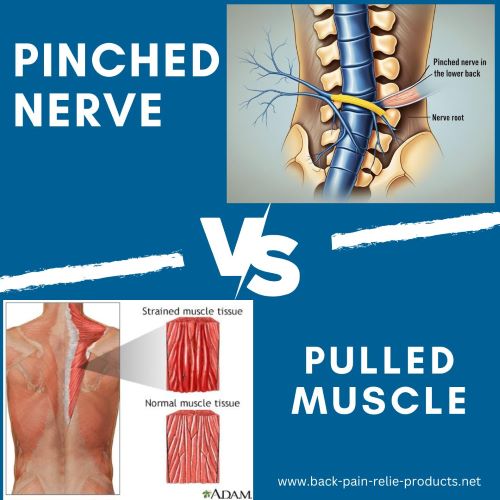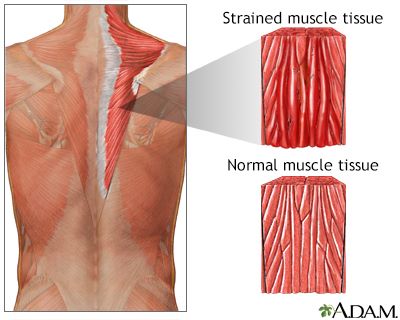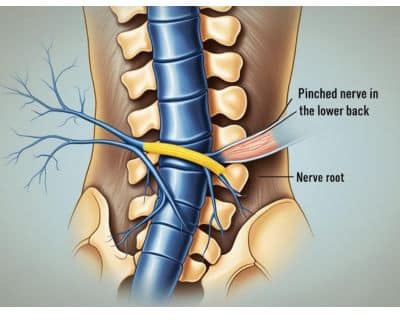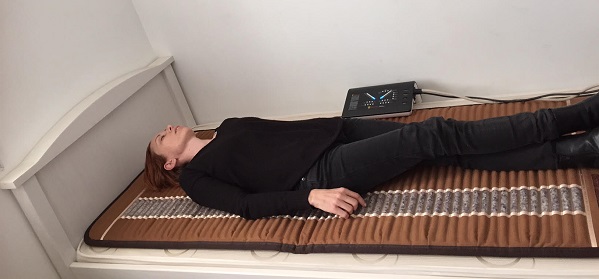How do you know if you have a pinched nerve or a pulled muscle?
Can a muscle strain cause nerve damage?
And how to treat both of these conditions – at home?

Finding the cause of your back pain without a physician’s examination is difficult.
However, this guide will reveal 2 simple ways to determine if your back pain is caused by a pinched nerve or a pulled muscle, and how to heal both – naturally and quickly.
This post may contain affiliate links, at no extra cost to you.
Overview
Pinched Nerve or Pulled Muscle? (How to Know)
Clue #1 – Nature of the Pain
A pulled muscle occurs when you tear or overstretch some of your muscle fibers.
A pulled muscle is usually described as a dull aching pain. Injured muscles can cause a surprising amount of pain and can become inflamed and spasmed, causing back pain and significant stiffness.
Muscle strain can also feel like throbbing, tenderness, cramping, stiffness, and aching and accompanied by swelling.
A compressed (pinched) nerve happens when the pressure in an area causes the nerve impulses to become partially blocked. You may experience radiating, burning pain in the affected area.
The pinched nerve feels more like sharp-shooting pain and may be accompanied by numbness and tingling.
Clue #2 – Pain Location
A pulled muscle is usually localized in one area. The area should feel tender when touched, and when you try to use the muscle, you feel immediate pain.
Nerve pain in the lower back can be felt all along the course of the nerve and usually radiates down the length of the leg, so you feel back pain along with pain in one or both of your legs.
There are many other signs of nerve injury: muscles that get smaller, color change in the skin, and changes to the amount of sweat in certain areas.
However, these symptoms are less common in cases of minor or transient pinched nerves. Severe changes (e.g., muscle atrophy) typically occur only if the nerve compression is left untreated for a long period.
Can a Muscle Strain Cause Nerve Damage?
According to the Mayo Clinic, nerve injury can happen due to stretching or pressing on the nerve, and also as a result of conditions that affect the nerves, such as diabetes.
A muscle strain can irritate the local nerves, but it most likely won’t cause severe nerve damage, such as a complete cut of the nerve.
Nerve damage from a pulled muscle will heal on its own.
Severe or worsening symptoms such as prolonged numbness, significant weakness, or radiating pain should be evaluated by a doctor.
How to Home Treat a Pulled Muscle in Your Back

A muscle strain, also called a pulled muscle, occurs when a muscle is overstretched or overworked, and small tears occur within the muscle.
A strained muscle can take up to 6 weeks to heal completely. Severe strains or tears may take longer, and bad management can prolong recovery time.
However:
You can speed your recovery in many ways:
1. Rest and Gentle Movement: Avoid activities that strain the affected muscle, but don’t stay completely inactive. Gentle movement helps maintain circulation and prevents stiffness.
2. Self-Massage – Using a simple self-massage tool can promote blood circulation to the injury area in your back and speed up healing significantly.
Other simple and effective ways to massage your back are massage guns for back pain, an electric massage mat, a vibrating foam roller, and more. See all our recommended back massage devices.
3. Infrared Heat Therapy – using an infrared heating pad, which emits deep-penetrating IR rays up to 3 cm inside your tissues, can relieve your pain without pills, for more than 6 hours post-treatment.
I have the BioMat at home, which is my in-house doctor, and I use it all the time, but I also have the less costly and smaller UTK infrared heating pad at home, used regularly by my entire family.
See the 5 best infrared heating pads for back pain.
4. Gradual Strengthening Exercises: Once the pain subsides, incorporate light stretches and strengthening exercises to rebuild muscle stability and flexibility.
How to Treat a Lumbar Pinched Nerve

There are a few possible causes for a pinched nerve (slipped disc, herniated disc, ruptured disc, degenerative disc disease, and piriformis syndrome).
But no matter the cause, there are a few simple steps you have to take to naturally cure your pinched nerve.
A pinched nerve requires relieving the pressure on the nerve to allow it to heal. Here are two key steps:
1. Spinal Decompression: stretches the spine, creating space between the vertebrae and relieves pressure on the nerve.
At-home options include inversion therapy (use a high-quality inversion table like the Innova ITX 9600 or the excellent Teeter Inversion tables) to elongate the spine. Even a few minutes a day can help.
If inversion therapy isn’t your preference, the Stamina Inline Traction System is an effective alternative for spinal decompression without hanging upside down.
2. Targeted Stretches and Exercises: do some gentle stretches to improve flexibility and relieve nerve compression. We do the child’s pose, cat-cow stretch, and piriformis stretch daily.
Avoid exercises that exacerbate pain. A physical therapist can guide you in choosing safe movements.
3. Infrared Heat Therapy: As with pulled muscles, infrared heating pads can relax the muscles around the nerve, reduce inflammation, and improve blood flow to promote healing.
4. Posture Correction: Poor posture can worsen nerve compression. Focus on sitting and standing with proper alignment to reduce pressure on the lumbar spine.
Understanding the difference between a pinched nerve and a pulled muscle is the first step to effective home treatment.
With the right care and lifestyle adjustments, you can heal naturally and prevent future pain.
To your health and happiness,
The Back Pain Relief Products Team



